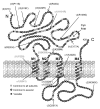Molecular mechanisms of antiseizure drug activity at GABAA receptors
- PMID: 23683707
- PMCID: PMC3766376
- DOI: 10.1016/j.seizure.2013.04.015
Molecular mechanisms of antiseizure drug activity at GABAA receptors
Abstract
The GABAA receptor (GABAAR) is a major target of antiseizure drugs (ASDs). A variety of agents that act at GABAARs s are used to terminate or prevent seizures. Many act at distinct receptor sites determined by the subunit composition of the holoreceptor. For the benzodiazepines, barbiturates, and loreclezole, actions at the GABAAR are the primary or only known mechanism of antiseizure action. For topiramate, felbamate, retigabine, losigamone and stiripentol, GABAAR modulation is one of several possible antiseizure mechanisms. Allopregnanolone, a progesterone metabolite that enhances GABAAR function, led to the development of ganaxolone. Other agents modulate GABAergic "tone" by regulating the synthesis, transport or breakdown of GABA. GABAAR efficacy is also affected by the transmembrane chloride gradient, which changes during development and in chronic epilepsy. This may provide an additional target for "GABAergic" ASDs. GABAAR subunit changes occur both acutely during status epilepticus and in chronic epilepsy, which alter both intrinsic GABAAR function and the response to GABAAR-acting ASDs. Manipulation of subunit expression patterns or novel ASDs targeting the altered receptors may provide a novel approach for seizure prevention.
Keywords: Antiepileptic drugs; Chloride channel; Epilepsy; GABA receptor; Inhibition; Seizures.
Copyright © 2013 British Epilepsy Association. Published by Elsevier Ltd. All rights reserved.
Figures


Similar articles
-
Isobolographic Analysis of Antiseizure Activity of the GABA Type A Receptor-Modulating Synthetic Neurosteroids Brexanolone and Ganaxolone with Tiagabine and Midazolam.J Pharmacol Exp Ther. 2020 Mar;372(3):285-298. doi: 10.1124/jpet.119.261735. Epub 2019 Dec 16. J Pharmacol Exp Ther. 2020. PMID: 31843812 Free PMC article.
-
Possible alterations in GABAA receptor signaling that underlie benzodiazepine-resistant seizures.Epilepsia. 2012 Dec;53 Suppl 9(0 9):79-88. doi: 10.1111/epi.12037. Epilepsia. 2012. PMID: 23216581 Free PMC article. Review.
-
New GABA-Targeting Therapies for the Treatment of Seizures and Epilepsy: I. Role of GABA as a Modulator of Seizure Activity and Recently Approved Medications Acting on the GABA System.CNS Drugs. 2023 Sep;37(9):755-779. doi: 10.1007/s40263-023-01027-2. Epub 2023 Aug 21. CNS Drugs. 2023. PMID: 37603262 Free PMC article. Review.
-
Developmental pharmacology of benzodiazepines under normal and pathological conditions.Epileptic Disord. 2014 Oct;16 Spec No 1(Spec No 1):S59-68. doi: 10.1684/epd.2014.0690. Epileptic Disord. 2014. PMID: 25335485 Free PMC article. Review.
-
A multiorganism pipeline for antiseizure drug discovery: Identification of chlorothymol as a novel γ-aminobutyric acidergic anticonvulsant.Epilepsia. 2020 Oct;61(10):2106-2118. doi: 10.1111/epi.16644. Epub 2020 Aug 14. Epilepsia. 2020. PMID: 32797628 Free PMC article.
Cited by
-
The Effect of Anti-seizure Medications on the Propagation of Epileptic Activity: A Review.Front Neurol. 2021 May 27;12:674182. doi: 10.3389/fneur.2021.674182. eCollection 2021. Front Neurol. 2021. PMID: 34122318 Free PMC article. Review.
-
Efficacy of Retigabine on Acute Limbic Seizures in Adult Rats.J Epilepsy Res. 2015 Dec 31;5(2):46-59. doi: 10.14581/jer.15010. eCollection 2015 Dec. J Epilepsy Res. 2015. PMID: 26819936 Free PMC article.
-
(R,S)-trihexyphenidyl, acting via a muscarinic receptor-independent mechanism, inhibits hippocampal glutamatergic and GABAergic synaptic transmissions: Potential relevance for treatment of organophosphorus intoxication.Neuropharmacology. 2023 Nov 15;239:109684. doi: 10.1016/j.neuropharm.2023.109684. Epub 2023 Aug 6. Neuropharmacology. 2023. PMID: 37549771 Free PMC article.
-
Expecting medication misuse: a proactive approach to drug discovery to prevent fatal overdose.Future Med Chem. 2025 Mar;17(6):681-692. doi: 10.1080/17568919.2025.2476388. Epub 2025 Mar 17. Future Med Chem. 2025. PMID: 40091621 Free PMC article. Review.
-
Mechanisms of Psychiatric Comorbidities in Epilepsy.Curr Top Behav Neurosci. 2022;55:107-144. doi: 10.1007/7854_2020_192. Curr Top Behav Neurosci. 2022. PMID: 33723802
References
-
- Treiman DM. GABAergic mechanisms in epilepsy. Epilepsia. 2001;42(Suppl 3):8–12. - PubMed
-
- Olsen RW, DeLorey TM, Gordey M, Kang MH. GABA receptor function and epilepsy. Advances in Neurology. 1999;79:499–510. - PubMed
-
- Ben-Ari Y. Seizures beget seizures: the quest for GABA as a key player. Crit Rev.Neurobiol. 2006;18:135–144. - PubMed
-
- Sperk G, Furtinger S, Schwarzer C, Pirker S. GABA and its receptors in epilepsy. Advances in Experimental Medicine and Biology. 2004;548:92–103. - PubMed
-
- Macdonald RL, Olsen RW. GABAA receptor channels. Annual Reviews of Neuroscience. 1994;17:569–602. - PubMed
Publication types
MeSH terms
Substances
Grants and funding
LinkOut - more resources
Full Text Sources
Other Literature Sources
Medical

